 |

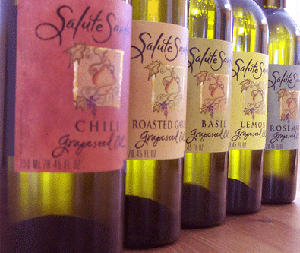 |
| Flavored grapeseed oils from Salute Santé! are cooking oil, salad dressing, anointing oil and the spice cabinet—all in one bottle. |
| WHAT IT IS: Grapeseed oil, infused in five flavors so natural-tasting, you’d swear you were eating the fresh herb or fruit. |
| WHY IT’S DIFFERENT: Grapeseed oil has a high smoke point, can be used for frying and baking and is one of the most heart-healthy oils (even more so than olive oil). |
| WHY WE LOVE IT: The flavored grapeseed oils are a cooking oil and an herb garden rolled into one. We need never worry about not having fresh herbs in the house. |
| WHERE TO BUY IT: SaluteSante.com. |
|
|
 |

Saluting The Grapeseed: Salute Santé! Flavored Grapeseed Oils
CAPSULE REPORT: After grapes are crushed for their juice, what happens to the skins and the seeds? For red wines, the skins often are kept in contact with the juice, to give more color to the wine, while the seeds are pressed to produce grapeseed oil. Grapeseed oil is a treasure: extremely heart-healthy, a dream to cook with (near-flavorless and with a very high smoke point). A top-quality flavored grapeseed oil is pretty amazing: an infusion of flavor—basil, chile, garlic, lemon or rosemary, e.g., has the effect of turning that herb or fruit into a pure liquid version of itself.
You won’t miss having fresh basil on a Caprese salad when you substitute basil-infused Salute Santé! grapeseed oil, so well does the infused oil substitute for a combination of fresh basil and a drizzle of oil. The lemon-infused oil tastes like liquid lemon zest. The Salute Santé! oils are used by chefs like Daniel Boulud, Eric Ripert of Le Bernardin and Charlie Trotter. For us it was love at first taste, long before we knew they had any famous friends. Read the full review below.*
*If your e-mail client does not support anchor links that jump to text above or below, e.g. AOL, please scroll down.
|
Learn How To Use Gourmet Oils
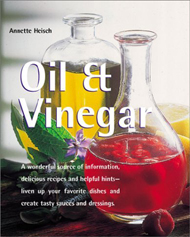 |
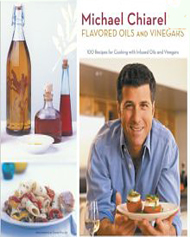
|
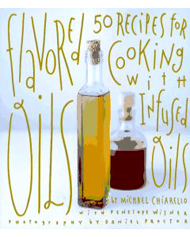 |
| Oil & Vinegar, by Annette Heisch. This comprehensive guide to oils and vinegars explains starts at the beginning: their origins and levels of quality, and how to shop for and store oils and vinegars. Along with many innovative recipes, Heisch shares the art of creating one’s own gourmet vinegars and oils. Click here for more information or to purchase. |
Michael Chiarello’s Flavored Oils & Vinegars: 100 Recipes for Cooking With Infused Oils & Vinegars, by Michael Chiarello. The Food Network chef shares 100 creative recipes for both making and using flavored oils
and vinegars that capture the essence of herbs, fruits, vegetables and spices. Sure to dazzle any dish. Click here for more information or to purchase. |
Flavored Oils: 50 Recipes For Cooking With Infused Oils, by Michael Chiarello with Penelope Wisner. The owner/chef of Napa Valley's Tra Vigne restaurant shares his wisdom about jazzing up ordinary dishes with flavored oils. Chiarello’s detailed advice on their judicious use includes instructions for infusions that are easy-to-follow. Click here for more information or to purchase. |
Salute Santé!: Flavored Grapeseed Oils
Grapeseed oil is a byproduct of winemaking, extracted from the grape seeds after the grapes are crushed for their juice. Not surprisingly, the oil is produced in winemaking regions like France and Italy, and more recently in California. “Subtle” and “neutral” are generally accepted descriptors; although as with olive oil, the flavor and aroma profile can vary based on grape cultivars. In other words, some oils can be “grapier” than others.
Grapeseed oil is a winner on every front: |

It may sound obvious, but grapeseed oil comes from the seeds of grapes. |
- Cooking. As a cooking oil, it has a very high smoke point—it can be heated up to 485°F when sautéing or frying with no smoking, spattering or burnt taste. It’s light and non-greasy with a neutral taste that does not overlay any flavor onto the foods being cooked. Thus, the fried chicken, zucchini et al retain their pure flavors. Only avocado oil, at 500°F, has a higher smoke point—and comes with the lovely but not-always-wanted flavor of avocado.* The neutral quality also makes grapeseed oil a versatile player that can be combined with stronger-flavored oils—sesame and walnut, for example—to tone down their assertiveness. It helps stretch the cost of the pricey nut oils as well.
*Refined oils remove the flavor.
- Health. Non-hydrogenated grapeseed oil is heart-healthy, high in vitamin E and Omega-6 fatty acids and very low in saturated fat. Studies indicate that grapeseed oil may be the only natural food known to raise HDL (the good cholesterol), which in turn loosens LDL (the bad cholesterol) from the arterial walls and carries it to the liver for elimination.‡ The brand name of the product salutes health.
‡Arteriosclerosis, Vol. 10, No. 6, Nov.-Dec. 1990; Journal of the American College of Cardiology, 925-116, March 1993; The Journal of Urology, Vol. 151, 54-61, Jan. 1995.
- Storage. Grapeseed oil does not harden or cloud when refrigerated. Marinades and salad dressings can be used straight from the refrigerator, without warming to room temperature. The oil can be stored at room temperatures of 70ºF or lower.
- Infusing. The neutral flavor of the base oil means that the flavored oils from Salute Santé! taste as if Mother Nature herself transformed fresh basil, chile, garlic, lemon and rosemary into an oil, standing ready to bring new life to an entire kitchen full of foods.
Note that grapeseed oil has no relation to rapeseed oil, one cultivar of which is canola oil. Rapeseed is a bright yellow flowering member of the family Brassicaceae (the mustard, cabbage and turnip family)—no kin to the fruit of the vine.
Salute Santé! Flavored Grapeseed Oils
The grapeseed oil is imported from Italy, where it is certified kosher, and the infused flavors are made in California (the flavored oils are not kosher). Salute Santé!’s plain oil is very elegant for cooking—so light and fresh that it reminds one of just how heavy and greasy most other cooking oils are. Here, there is no heavy oil draining out of fried chicken, for example, or leaving oil splotches on one’s fingers when eating the chicken.
But for the same reason it’s a great cooking oil, the plain oil doesn’t offer enough flavor to hold its own in a salad dressing. That’s where the infused grapeseed oils are spectacular: pure, bold, and leaping to add vigor to every food they touch. The herbs come from a biodynamic farm in California and are picked according to the biodynamic calendar for optimum intensity of flavor. No cook (or non-cook) will fail to be delighted with a set of these oils (and they are beautifully bottled and conveniently gift-boxed). They turn any food into a better dish. Let’s take a look at the oils, and then a more expanded list of serving suggestions and recipes.
- Basil Grapeseed Oil. Whether standing in for fresh basil with tomatoes and fresh mozzarella cheese or with regular salad greens in a vinaigrette, this oil brings garden basil straight to the table. Toss it with pasta or rice, or mix a spoonful into any sauce, soup or stew that begs for some fresh basil flavor.
- Roasted Garlic Grapeseed Oil. For a country that loves garlic, no wonder this is the best seller. It tastes as if the fresh garlic cloves are still in the bottle. Brush it on toasted baguette for instant garlic bread—there’s no need to do anything more. It makes a heavenly garlic mayonnaise. Use it as a cholesterol-free “butter” for corn on the cob. Yum!
|
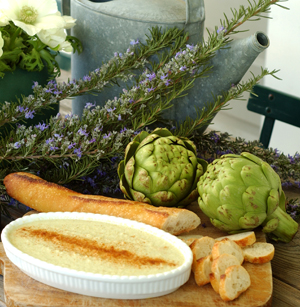 The recipe for this delicious artichoke dish with Chili
The recipe for this delicious artichoke dish with Chili
Grapeseed Oil is below. |

This apple galette uses Lemon and Rosemary grapeseed
oil instead of butter...and is lemony and delicious plus
cholesterol-free.
|
- Chili Grapeseed Oil. This is a pleasantly mild chili oil. If you want a spicier one, we refer you to two other products with a lot more kick.† Even Northeasterners like us can enjoy this chili oil with their morning eggs. Or use it in Chinese, Mexican or Thai dishes, or to add a little spice to everyday foods. We add a bit to gazpacho and to tuna salad. Add some sizzle to old standards like artichoke dip and three-bean salad.
- Lemon Grapeseed Oil. Wherever you’d normally love a squeeze of citrus and use oil, Lemon takes care of both. Use it as a non-cholesterol alternative to dipping seafood and artichoke leaves, as a base for dips and lemon mayonnaise, or combined with Roasted Garlic Grapeseed Oil as an aioli. We loved the fresh lemon zest flavor of this oil so much, we tossed fruit salad in it and poured it over vanilla ice cream for a lemon-creamsicle effect.
|
- Rosemary Grapeseed Oil. Fresh rosemary is heavenly with poultry and lamb, roasted potatoes and vegetables. The is no exception: we brushed it on just about anything!
In fact, we spent an entire week brushing, daubing, marinating and sprinkling Salute Santé! flavored grapeseed oils on everything that crossed our path—even regular, lemon and chocolate pound cakes (yes to basil, lemon and rosemary, no to chili and garlic). Join our culinary travels in the next section.
†For a delicious oil with real chile kick, try Olivado Avocado Oil’s Chili & Bell Pepper Oil. For a super chile kick, we love Gil’s Habañero Tequila Oil. Editor’s Note: Chile, chili and chilli are alternative spellings of the word. THE NIBBLE uses chile, except when we need to use a different spelling because a manufacturer has so named its product.
Serving Suggestions
Here’s what we did with the oils, along with notes on some of the many recipes available on the Salute Santé! website (that we haven’t tried yet). One thing’s for sure: with a cabinet of these oils, you need never again worry about having fresh herbs in the house.
Breakfast
- Every day we cooked a different style of egg in a different type of oil, mixing and matching omelets, fried and scrambled eggs with whatever flavor we were in the mood for. Favorite creations include two poached eggs on toast, one dribbled with Basil, one with Chili; and hard-boiled eggs with ramekins of “dipping oil” (all flavors) and different colored sea salts.
- The company website, SaluteSante.com, has a recipe for scrambled eggs made with Chili Grapeseed Oil.
Lunch
- Every day we tried a different oil with red wine vinegar, in a salad topped with a different protein: chicken, grilled or poached salmon, chicken sausages, scallops and shrimp. All of the
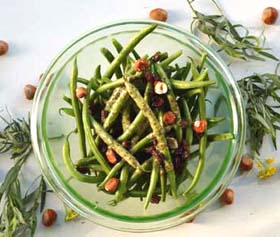 oils make wonderful vinaigrettes: we promise you’ll start eating more salads. oils make wonderful vinaigrettes: we promise you’ll start eating more salads.
- The Basil, Lemon and Rosemary oils go well with a citrus salad—grapefruit and orange segments with red onion, atop greens. You can have it alone, with yogurt, or add any proteins from the previous bullet.
- Use the oils as a dressing for pasta salad, potato salad, cole slaw et al.
- The SaluteSante.com website has recipes for Basil Salad Dressing, Edible Flower Salad, Tomato Salad and Tricolor Bean Salad (photo at right).
Condiments
- Combine the oils—especially Chili and Lemon—with soy sauce as a nouvelle dip for sushi, sashimi or seafood.
- Make flavored mayonnaise. If you’ve never had homemade mayonnaise before, you will be thrilled at how wonderful mayonnaise tastes.
Much commercial mayonnaise is made from grapeseed oil or soybean oil...plus egg yolks, lemon juice and/or vinegar, salt, sugar, optional seasonings like onion powder and preservative. Mayonnaise was invented in 1756 by the French chef of the Duc de Richelieu. After the Duc beat the British at Port Mahon, in the Balearic Islands in the Mediterranean off the coast of Spain, his chef created a victory feast. One dish was supposed to include a sauce made of cream and eggs, but the chef realized that he had no cream. He substituted olive oil and created a new sauce, named Sauce Mahonnaise in honor of the Duc’s victory. Mayonnaise is different from salad dressing, which doesn’t contain egg yolks and generally has more sugar.
- Use the oils as a bread spread. Remember our “instant garlic bread” suggestion earlier? You can have instant basil bread, chili bread, lemon bread and rosemary bread—each as yummy. Just toast the bread and brush on the oil. If you have fresh herbs of any kind, snip them and sprinkle a few on top. You can sprinkle on grated cheese, too, and stick it under the broiler until it melts.
Hors D’Oeuvres, Starters, First Courses & Sides
- There’s no need to buy separate “bread dippers”: any of these oils will have guests oohing and aahing. You can add salt and spices if you like, drizzle in some balsamic vinegar and snip in some contrasting herbs.
- Similarly, all flavors make great dipping oil for crudités—another way to get the family to eat more vegetables without needing to pile on cholesterol-laden dips.
- For a fancy hors d’oeuvre, serve hard-boiled quail eggs with different dipping oils and a cellar of sea salt.
- The recipe for Artichoke Dip with Chili Oil is below. For more ideas for starters that use the oils, check on the website for recipes for Avocado & Lemon Bruschetta, Basic Bruschetta, Fava Bean Dip, Fresh Tomato Tart, Pepper & Chili Bruschetta, Rosemary & Garlic Bruschetta and Mushroom Paté.
- Call us carb-happy, but we just love tossing these oils with pasta and rice.
- If you’re serving your own (or someone else’s) soup and it needs a pick-me-up, add a few droplets of your favorite flavored oil. Website recipes for soups that use the oils: Corn Bisque with Red Bell Pepper and Rosemary and Zucchini & Basil Soup with Squash Blossom Croutons. The recipe for Cream of Winter Squash Soup is below.
- Roasted potatoes are a natural with the oils, and there are recipes on the website for Herb Roasted Potatoes and Roasted Rosemary Leeks & Potatoes. We made mashed potatoes with all of the oils—individually and in blends, including Basil Chili, Garlic Basil and Garlic Rosemary. For anyone who likes mashed potatoes, this could be a long and delightful occupation.
Dinner
- Baste, marinate, fry, sauté, roast—cook as you will. After the food is cooked, you can drizzle the oil over it. We love it on fish, beans and grains, noodles, potatoes, rice and vegetables. Instead of drizzling directly on the food, you can use a medicine dropper and dot drops of oil evenly around the perimeter of the plate.
- The website has recipes for Barbecued Ribs, Grilled Chicken, Grilled Salmon Fillet and Lemon Fish Fillet that use the different oils. Every time we look at them we get very hungry.
We must admit to being hung up on rosemary chicken. Before we met Salute Santé! Rosemary Oil, we would painstakingly stuff sprigs of rosemary under much of the skin of our hen before roasting. It would infuse the bird with a divine aroma and flavor. Now, we wave our basting brush: whisk, whisk, whisk. No, it doesn’t look as pretty as the green herb, and yes, it is taking the easy way out. But it is delicious. Along with those garlic rosemary mashed potatoes.
Recipes
Two crowd-pleasers for family dinners or fall entertaining:
Cream of Winter Squash Soup Recipe
Ingredients
- 1 small pumpkin or 1 medium squash
(acorn or butternut)
- 1 medium onion
- 3 cloves garlic
- 3 tablespoons Salute Santé! Chili
Grapeseed Oil
- 3 tablespoons Salute Santé! Grapeseed
Oil
- 6 cups vegetable or chicken stock
- 1/4 cup sugar
- Salt & pepper to taste
Directions
- Cut up squash or pumpkin into sections. Place in a baking dish with onion and garlic slices.
- Rub all with Salute Santé! Chili Grapeseed Oil. Sprinkle with salt, pepper and half the sugar.
- Bake at 350ºF for 1 to 1-1/2 hours until tender.
- Remove onion and garlic and place in a soup pot. Sauté in Salute Santé! Grapeseed Oil about 7 minutes.
- Scoop pumpkin out of shell. Add to soup pot with stock. Add remaining sugar. Bring to a boil and then simmer 20 minutes. Let cool, then purée until creamy and thick.
|
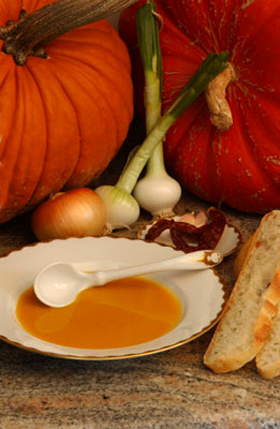
Cream of Winter Squash Soup.
|
Serves 4.
Artichoke Dip
Photo above
Ingredients
- 2 cans artichoke hearts (reserve 1/2 liquid from can)
- 2 big cloves of garlic
- 1/4 cup Salute Santé! Chili Grapeseed Oil
- Salt to taste
- Hungarian paprika
- Sourdough baguette
Directions
- Preheat oven to 350ºF. Mix first four ingredients in blender. Purée briefly.
Place in oven-proof serving dish. Sprinkle paprika on top.
- Bake for 20 minutes until bubbly at edges. Serve with baguette slices.
Serves six as an appetizer. Also great as a spread on a mozzarella and grilled vegetable sandwich.
Yield: 3/4 cup
Other “Alternative” Oils
While most Americans grew up on a diet of vegetable oil, corn oil and olive oil, there are dozens of delicious oils used in food preparation. You can read about all of them in our Culinary Oil Glossary. Here are a few selections:
|
Avocado Oil: Good-quality, first-pressed avocado oil has a vibrant green color like the skin of the fruit and tastes and smells mildly of avocado—though some versions can be highly refined to achieve a neutral scent and taste. The monounsaturated oil has the highest smoke point of the fruit and vegetable oils, 500°F. Some are infused with citrus, herbs and chile—see our review of Olivado Avocado Oil.
Chile (or Chili) Oil: Used in many parts of Asia, traditional chile oil is usually vegetable oil infused with dried chiles, which give it a slightly orange color. Hot and spicy, it is used for flavoring dishes, rather than as a cooking oil. Today, gourmet olive oils flavored with chiles can also be found. See our review of Gil’s Habañero Tequila Oil.
Nut Oils: Strongly-flavored, fragile and expensive, oils from hazelnuts, pistachios and walnuts make delicious salad dressings and anointing oils. They need to be stored in the refrigerator and used up quickly.
Pumpkin Seed Oil: Pumpkin seed oil, pressed from roasted pumpkin seeds, is thick, dark and opaque with a strong flavor. It can be combined with milder oils for salad dressings or used undiluted to add a distinctive flavor to fish or vegetables.
Rice Bran Oil: A slightly nutty oil extracted from the bran and kernel of rice, rice bran oil became commercially available in the United States in the mid-1990s. It has a high smoke point that is good for cooking, and is gaining popularity for its healthy qualities: high level of the antioxidant vitamin E and a good balance of mono- and polyunsaturates.

|
 |
Sesame Oil: Unrefined sesame oil is made by crushing sesame seeds and filtering the resulting oil, which is light and has a mild flavor. It is very popular in Middle Eastern and Indian cooking, and gives good flavor to stir-frys and salad dressings. Dark sesame oil is where the excitement lies: the seeds are toasted before crushing to produce a darker oil with an intense fragrance and robust flavor (it is very strong—we often mix 1 tablespoon of it along with 2 tablespoons of olive oil in a vinaigrette). When using it in stir-frys and marinades for meat or fish, blending dark sesame oil with milder oils will tone down the delicious but intense flavor.
Tea Oil: Tea oil is cold-pressed from the seeds of the tea plant, Camellia sinensis. A pale amber-green in color, the oil has an herbal aroma with a somewhat sweet flavor. It is high in vitamin E and other antioxidants, contains no trans-fatty acids, is lower in saturated fat than olive oil and is non-hydrogenated. It is often used in Asian foods and it can be served as a salad dressing when it is combined with other flavors, such as lemon or lime. Tea oil has a high smoke point so it can be used for frying and sautéing. While it is relatively new in the U.S., it is being discovered as a gourmet oil for dips, dressings, marinades, pasta, sauces and vegetables.
Truffle Oil: Truffle oil generally contains little actual truffle, but is produced by infusing a high-quality oil, such as extra virgin olive oil, with the flavor from truffles. The truffles are soaked in the oil until it absorbs flavor and aroma. The oil can be used to add the truffle flavor to a variety of foods; however, it must be tossed on or dribbled on, since heating the oil will cause the flavor and aroma to dissipate. Similarly, an open bottle of truffle oil will lose its flavor quickly and should be used up in a short period of time.

|
Food Fun
The oils are available in beautiful gift bottles—appropriately, wine bottles—and the plain oil is also packaged in handsome metal cans. A variety of gift assortments will take care of anyone on a personal or corporate gift list. If you buy all five of the infused flavors for yourself (which gets our vote), you get a sixth bottle free—which would make a nice gift for someone else.
Cooking can be so much fun when you have the right ingredients to play with. With a set of flavored grapeseed oils from Salute Santé!, you are an artist. Food is your canvas, the accent flavors are your paints. Whatever you do (overcooking the exception), it tastes great!
—Karen Hochman
FORWARD THIS NIBBLE to anyone who loves to cook—or who doesn’t, and wants an easy way to make very tasty, heart-healthy food.
SALUTE SANTE! GRAPESEED OILS
Plain Grapeseed Oil
Grapeseed Oil Infused With Basil, Chili, Lemon,
Roasted Garlic, Rosemary
Plain Grapeseed Oil Is Certified Kosher By Rabbi Abraham Hochwald Landesrabbiner V
- 8-Ounce Bottles, Any Flavor
$13.00
- 3-Bottle Gift Box: Basil, Garlic, Lemon
$37.50
- All 5 Flavors
8-Ounce Bottles
$65.00
Get a sixth bottle free
- Plain Grapeseed Oil
17-Ounce Bottle With Pour Spout
$18.95
17-Ounce Can
$11.50
Other Sizes Available On Website
Purchase online* at GrapeseedOil.com
or telephone 1.707.251.3900
E-mail: Info@GrapeseedOil.com
*Prices and product availability are verified at publication but are subject to change. Shipping is additional. THE NIBBLE does not sell products; these items are offered by a third party and we have no relationship with them. This link to purchase is provided as a reader convenience.
|
 |
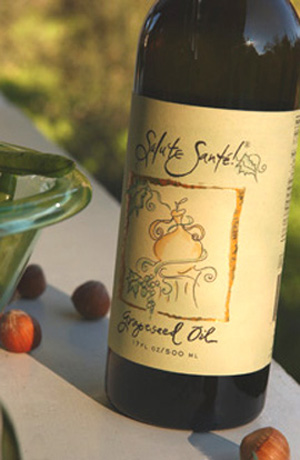
Plain Grapeseed Oil, shown in a gift bottle. |
Read more about our other
favorite oils and condiments
in THE NIBBLE online magazine
(links at right) and don’t miss
these great articles:
|
Have A Favorite Oil, Vinegar or Dressing?

|
THE NIBBLE does not sell the foods we review
or receive fees from manufacturers for recommending them.
Our recommendations are based purely on our opinion, after tasting thousands of products each year, that they represent the best in their respective categories. |
FOR ADDITIONAL INFORMATION, special offers,
contests, opinion surveys, THE NIBBLE
back issues archive, product gift-finder, links to our favorite
food websites, and the ability to nominate YOUR favorite nibbles,
visit the home page of TheNibble.com.
Do you have friends who would enjoy THE NIBBLE?
Click here to send them an invitation to sign up for their own copy. |
ABOUT THE NIBBLE. THE NIBBLE™, Great Food Finds, is an online magazine plus newsletters about specialty foods and the gourmet life. It is the only consumer publication and website that focuses on reviewing the best specialty foods and beverages, in every category. The magazine also covers tabletop items, gourmet housewares, and other areas of interest to people who love fine food.
© Copyright 2004-2025 Lifestyle Direct, Inc. All rights
reserved. All information contained herein is subject to change at any time
without notice. All details must be directly confirmed with manufacturers, service
establishments and other third parties. The material in this newsletter may not
be reproduced, distributed, transmitted, cached, or otherwise used, except with
the prior written permission of Lifestyle Direct, Inc.
|
 |
|
 |













 oils make wonderful vinaigrettes: we promise you’ll start eating more salads.
oils make wonderful vinaigrettes: we promise you’ll start eating more salads. 